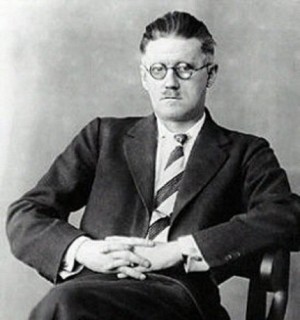
Ever since its first appearance in 1922 James Joyce’s Ulysses, a cornerstone of Modernist literature, has been considered to be one of the most significant novels of the 20th Century and the controversy and debate it has always generated is a significant part of its attraction. The very fact that it was banned for 12 years for obscenity in America and Britain not only added to its appeal, but also helped create a complicated publishing history, as the various publishing houses endeavoured to bring this landmark work to the wider public.
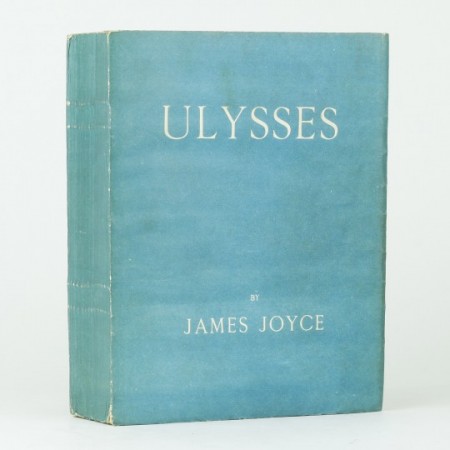
Joyce’s modernist recasting of Homer’s epic began, conceptually at least, with a letter to his brother Stanislaus in 1906. That letter recorded the first reference to Ulysses, which was then intended as a short story to be included in Dubliners. From 1916, Joyce refers in his letters to writing Ulysses. Parallels have been drawn in the peripatetic lifestyles of both Homer and Joyce whilst their epics were under construction, and in a letter to John Quinn in 1921, he refers to his itinerant existence. “When Ulysses is finished, after seven years of labour (diversified by eight illnesses and nineteen changes of address, from Austria to Switzerland, to Italy, to France) I shall need six months rest”. Joyce wrote about having finished Ulysses as early as October 1921, although Sylvia Beach recalls adding Joyce’s last page of manuscript only two days before the first copies were printed.
The birth of Ulysses was almost as traumatic as its conception. On the recommendation of Ezra Pound, Margaret Anderson serialised the novel in her literary magazine Little Review between 1918 and 1921. In September 1920 a New York lawyer complained that his daughter had received an unsolicited copy of the July-August copy of Little Review, which contained part of Nausicaa, the 13th episode of Ulysses. Anderson and her co-editor and lover, Jean Heap, were both charged with the distribution of “obscene, lewd, lascivious, filthy, indecent, or disgusting” material, found guilty and fined fifty dollars each, and it was also stipulated that no further installments of Ulysses could be published, which ultimately finished the Little Review. As a result of this debacle, Joyce feared that even should he be able to find a publisher, the act of serialization and the stigma attached to the work following the court case would make the novel unsaleable. It was to Sylvia Beach and her small Parisian bookshop, Shakespeare and Company, that Joyce turned. Beach, like Andersen before her, immediately saw the genius in Ulysses and wrote in a letter to her mother that she might be soon to publish “the most important book of the age”.
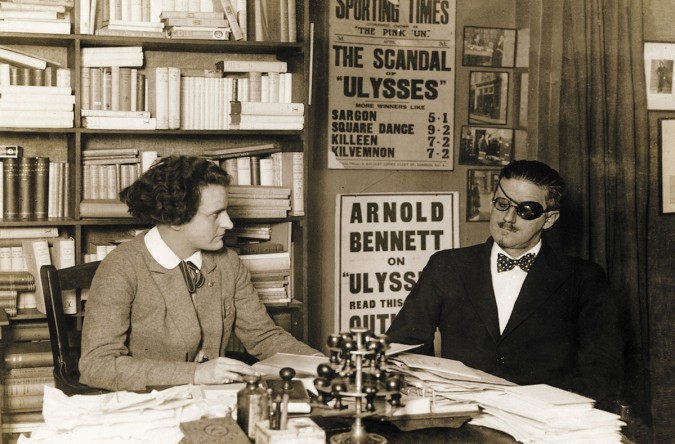
James Joyce and Sylvia Beach in Shakespeare & Co. Paris
A printer was found in Maurice Darantiere of Dijon and publication was planned for October. However, Joyce’s continual rewriting of the text and Beach’s perfectionism in the printing process led the publication date to be continually moved back and eventually 2 February 1922, Joyce’s birthday, was settled upon. Even then only two copies were ready, sent by Darantiere via the Paris-Dijon express. One was put on display at Shakespeare and Company, and the other taken, unopened by Joyce, to his birthday celebrations at the Italian restaurant, Ferrari’s. “He had brought with him a package containing his copy of Ulysses, and placed it under his chair. Nora remarked that he had thought about the book for sixteen years, and spent seven years writing it. Everyone asked to see it opened, but he seemed to shrink from producing it. After the dessert he at last untied the parcel and laid the book on the table. It was bound in the Greek colours – white letters on a blue field – that he considered lucky for him and suggesting the myth of Greece and Homer, the white island rising from the sea. There was a toast to the book and its author which left Joyce deeply moved” (Richard Ellman – James Joyce).
Colophon page of the first edition of Ulysses
One thousand copies were issued by subscription. 100 copies on Holland handmade paper (signed), 150 copies on verge d’Arches and 750 copies on linen. A further 20 copies were produced, largely unwrappered on mixed paper and marked, “press copy”.
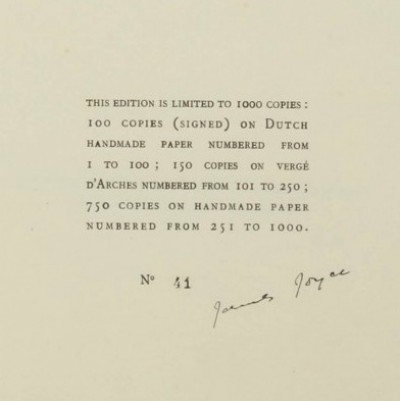
News of the book spread among the Paris literati and it was instantly in demand. All thousand copies of the first edition were sold within a month. The book was quickly reprinted, but due to the obscenity ruling of 1921, the book could not be published in either Britain or America. The second and third printings, in October 1922 and January 1923, were by John Rodker, Paris, for the Egoist Press in London. The two printings added a further 2500 copies to the market, but although some copies were successfully smuggled into both countries many were seized by Customs and destroyed.
The fourth printing in 1924, was by the Shakespeare Press, and was the first to change from the traditional 'Greek flag' wrappers design, being published in cream wrappers titled in blue on the spine and upper cover and with Price: Sixty Francs printed in blue on the rear cover. "In the fourth, fifth and sixth printings the text was corrected for the errata which had been issued with the second and third printings, but more typographical errors which had been discovered were listed as Ulysses/Additional corrections and included in the regular pagination" (John Slocum & Herbert Cahoon – A Bibliography of James Joyce).
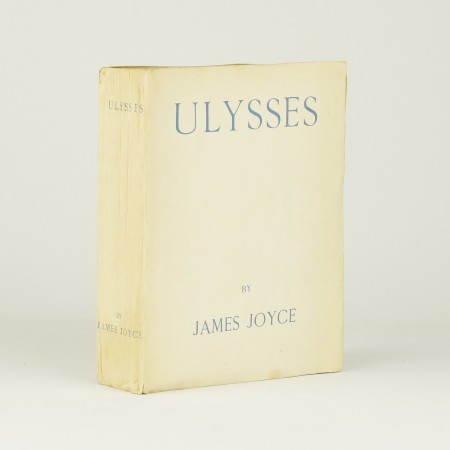
The fourth edition of Ulysses - a change from the blue wrappers
In 1932 Ulysses was fully reset again, corrected by Stuart Gilbert under Joyce's direction and published by the Odyssey Press, Hamburg. It is generally considered to be the most accurate and authoritative texts of the book and it remains one of the key lifetime editions of this work The first printing of the Odyssey Press edition was published in 3 formats: a single volume on thin paper in creamy white cloth (the first edition of Ulysses to be bound in cloth); a two volume-set bound in grey card covers; and a slightly taller two volume-set also in grey card covers of which only 35 copies were printed.
Odyssey Press edition from 1932
It was not until the 1933 decision in the US District Court, overturning the earlier successful prosecution of the Little Review, that legitimate publication of Ulysses in Britain and America became possible. Judge Woolsey’s trial summing up constitutes one of the greatest pieces of literary criticism ever delivered from the bench. He stated “The words which are criticized as dirty are old Saxon words known to almost all men and, I venture, to many women”. Joyce, the judge went on to say “has honestly attempted to tell fully what his characters think about… In many places it seems to me disgusting, but although it contains many words usually considered dirty, I have not found anything that I consider to be dirt for dirt’s sake”. Joyce was, the judge concluded, “a great artist in words” and as Ulysses did not have “the leer of the sensualist” it could not be considered to be pornographic. Random House, who had instigated the trial, had the text and cover design ready and had arranged matters so that upon a positive outcome the book could be set, proofread, printed, bound and delivered within five weeks. Immediately following the ruling in December 1933, therefore, Random House were able to rush into publication on 25 January 1934, with an initial 100 copies of the first authorized American edition (a pirate American edition, based on the ninth Shakespeare printing was in circulation in 1929). A year later The Limited Editions Club, New York, published 1500 copies of an edition illustrated by Henri Matisse, using the text from the Odyssey Press (second impression) 1933 edition.
The British courts withdrew their objections in 1936, at which point Bodley Head brought out an edition based on the text of the second impression of the Odyssey Press edition. Bodley Head decided to limit publication to 1,000 copies, paralleling the 1922 publication, with the first 100 bound in vellum, printed on mould made paper and signed by Joyce. The remaining 900 copies were bound in green buckram, printed on Japon and issued in a dustwrapper. The edition is particularly beautiful, with an Homeric bow design by Eric Gill on the upper cover, and is the first to contain appendices relating to the legal case surrounding publication, as well as the first bibliography of Joyce.
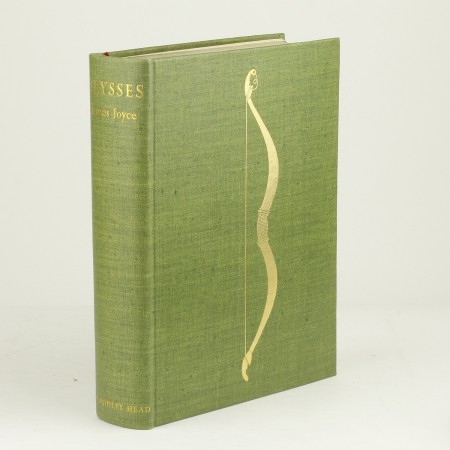
Eric Gill cover design to the 1936 Ulysses
Since 1936 Ulysses has rarely been out of print, and as the foremost work of the Modernist Movement it continues to be a source of interest, debate and analysis, but it is also a landmark case of literary merit vs the obscenity laws, a fascinating part of publishing history and is undoubtedly a “must have” for any serious collector of 20th Century English literature.
Read more about James Joyce.
View first ediitons and other books by James Joyce.
Comments
Recent Posts
- The Evolution of Crime
- Tour The Bookshop On Your Screen
- The Genesis of Mr. Toad: A Short Publication History of The Wind In The Willows
- Frank Hurley's 'South'
- The "Other" Florence Harrison
- Picturing Enid Blyton
- Advent Calendar of Illustration 2020
- Depicting Jeeves and Wooster
- Evelyn Waugh Reviews Nancy Mitford
- The Envelope Booklets of T.N. Foulis
- "To Die Like English Gentlemen"
- Kay Nielsen's Fantasy World
- A Brief Look at Woodcut Illustration
- The Wealth Of Nations by Adam Smith
- What Big Stories You Have: Brothers Grimm
- Shackleton's Antarctic Career
- Inspiring Errol Le Cain's Fantasy Artwork
- Charlie & The Great Glass Elevator
- Firsts London - An Audio Tour Of Our Booth
- Jessie M. King's Poetic Art, Books & Jewellery
Blog Archive
- January 2024 (1)
- January 2023 (1)
- August 2022 (1)
- January 2022 (1)
- February 2021 (1)
- January 2021 (1)
- December 2020 (1)
- August 2020 (1)
- July 2020 (2)
- March 2020 (3)
- February 2020 (2)
- October 2019 (2)
- July 2019 (2)
- May 2019 (1)
- April 2019 (1)
- March 2019 (2)
- February 2019 (1)
- December 2018 (1)
- November 2018 (1)
- October 2018 (2)
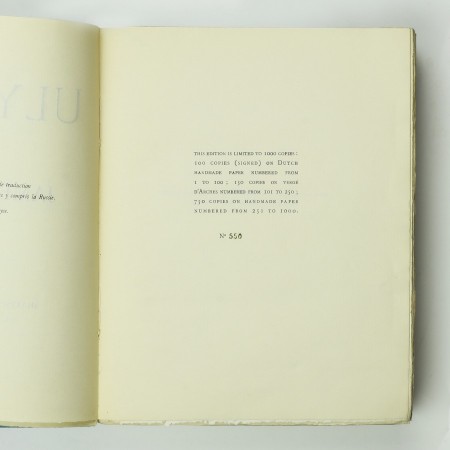
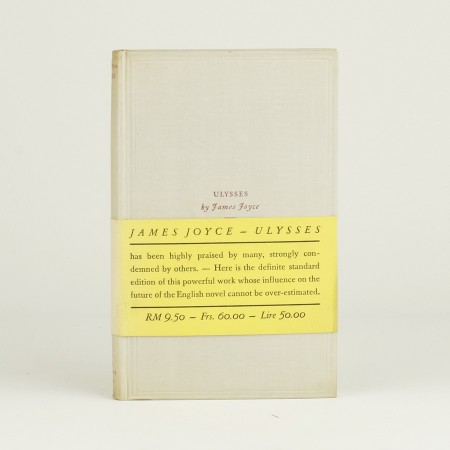
jm raynal 05/May/2020 06:05
to the point, informative, illustrated with economy, and all about what the title says it is about, and nothing more.
Thank you.
Michael Drake 09/Feb/2016 15:13
excellent treatise......